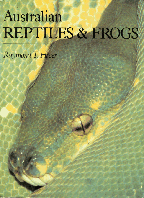
PRESERVING SPECIMENS
For a number of reasons it is often necessary to preserve live or dead reptiles and frogs. If a dead herptile is to be dissected within a few months of being killed, it is best kept in a frozen state. When other preservatives are not available, a freezer is always an excellent temporary storage place.
If live specimens are to be killed to be preserved (usually only for museum and scientific collections), then freezing of specimens is the most humane and painless way to do so. (The metabolic rate is slowed down gradually until it stops/death). Various anesthetics may be used to kill specimens, but they are not as desirable as killing by freezing.
The best solution for preserving herptiles is 60-75% ethyl alcohol. The lesser concentrations should be used for softer bodied herptiles, whilst higher concentrations should be used for larger and harder bodied herptiles.
A solution of 7-10% formalin is also excellent for preserving specimens.
Frogs, tadpoles and frogs eggs are best preserved in 8 % formalin with small amounts of calcium chloride and cobalt nitrate added. (Tadpoles and frogs eggs should never be preserved in alcohol based solutions).
Methylated spirits and other alcohol based solutions, including high alcohol liquor make good preservatives, and are readily obtainable even in remote areas.
It is often advisable to inject specimens with preservative when preserving them, to avoid decay before the preservative seeps through to the internal parts. 'Fixing' specimens into desirable positions can be done by injecting them with preservative (formalin is best for fixing), and then positioning the body into a desirable position before it stiffens. Hemipenes of snakes and lizards can usually be everted by injecting preservative into the base of the tail behind the hemipenes.
Addition of 10% glycerine to preservatives may help maintain 'softness' of specimens.
Specimens should be stored in screw capped plastic or glass jars, with as little air within as is possible. The seal should be perfect to prevent evaporation of preservative, and metal lids should be avoided as they will corrode, and eventually leak.
As for live reptiles, detailed records should be kept. For each specimen one should record the following:
1/ Species,
2/ Date,
3/ Locality,
4/ Person who obtained specimen,
5/ Other significant data.
Specially made labels for preserved specimens are available. These contain a file number and may be tied to the specimen within the container. The specimen number correlates with notes kept in proximity to the preserved specimen.
One should make sure that labels and writing attached to specimens is not adversely affected by the preservative. Labels made of rag based paper, and written in pencil or Indian ink are usually effective.
To continue to the rest of this section (Warning Notice)

The above was from the book Australian Reptiles and Frogs by Raymond Hoser and now available on a fantastic CD-Rom along with a vast amount of other information, papers and the like on reptiles, frogs and other wildlife.